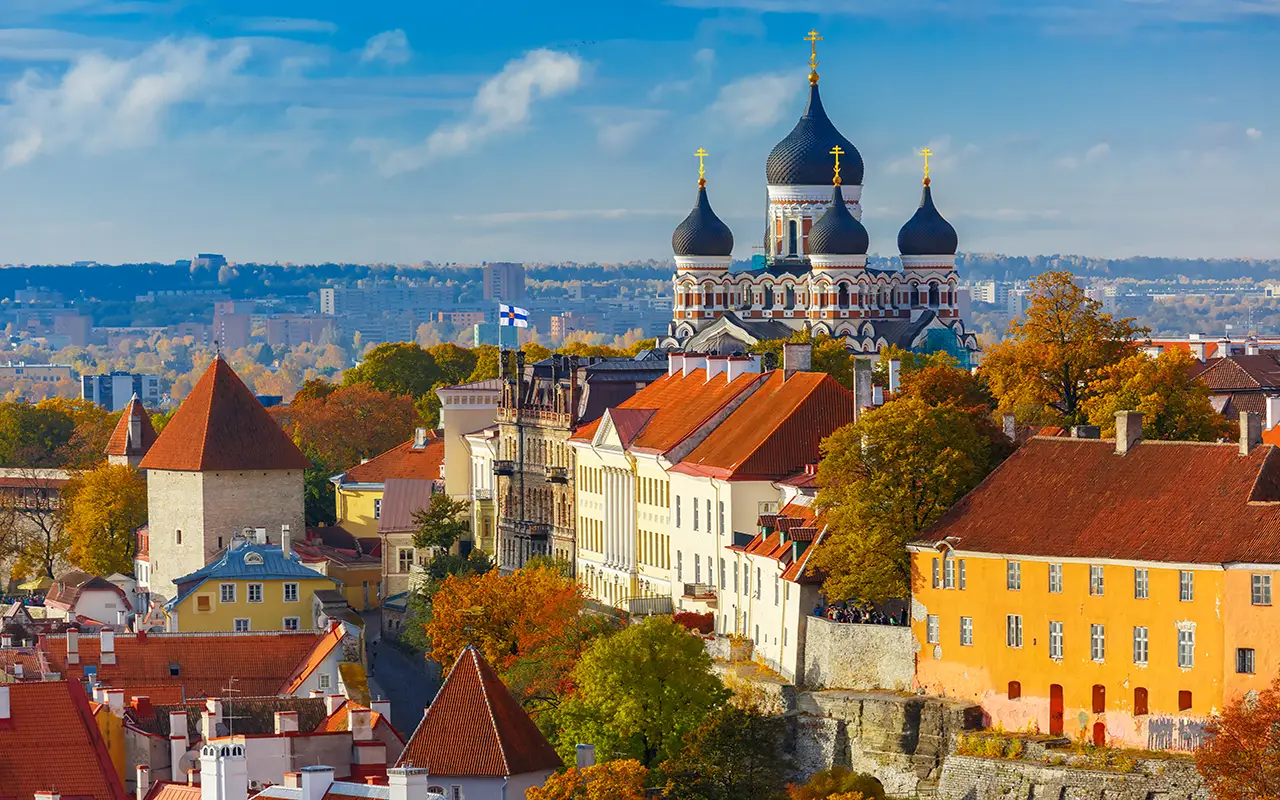
Table of Contents
Overview of Estonia
A northern European Baltic country bordered by Latvia to the south and Russia to the east, Estonia extends into the Baltic sea to the west. Also comprised of multiple large islands, Estonia is separated from Finland by the Gulf of Finland. Its population of 1.3 million speak Estonian. Historically occupied by neighboring Nordic countries as well as Poland and Russia, Estonia briefly became an independent state, but was subsequently absorbed into the Soviet Union post-WWII. After 5 decades behind the iron curtain, Estonia achieved its independence 1991. Today, it’s one of the most digitally advanced countries in the world; one of the only states to offer both tax filing and national voting by computer. Estonia’s ancient history and modern reality are best reflected in its coastal capital Tallinn, home to both a UNESCO Heritage Site and most of the development team of Skype, one of the world’s most popular telecommunication applications. Tallinn’s walled-Old Town stands as one of northern Europe’s best-preserved medieval urban centers. Dominated by its 12th century St. Olaf’s church and the limestone Toompea hill, Old Town boasts winding cobblestone medieval streets. Visitors to Tallinn can sample traditional Estonian cuisine of black bread and potatoes; peasant fare increasingly influenced by Nordic culinary and aesthetic traditions. The rumored birthplace of marzipan, Tallinn offers a delicious variety of Estonian desserts. Maiasmokk, the city’s oldest café, boasts a museum dedicated to the sugary confections and sells pastries and hand-painted Marzipan creations shaped by historic molds. Explore Estonia’s Russian heritage, most visible in the Alexander Nevski Cathedral, designed in the Eastern Orthodox Style, and Kadriorg art museum and park, the 18th century palace and garden complex commissioned by Czar Peter the Great. Outside the capital, you can visit Estonia’s numerous villages and island towns dotted with historic manor houses. Explore the medieval coastal town of Pärnu, which dates to the 13th century, and offers a sandy beach and spas in addition to historic architecture. For nature, Matsalu national park boasts some of the best bird watching in Europe. Estonia signed the Schengen agreement in 2003, becoming part of the Schengen area in 2007.
Estonia Schengen Visa Eligibility
Schengen visa eligibility for Estonia includes third country nationals from the following states, who are excluded from visa-free to Estonia/the Schengen area, and are therefore eligible to apply for a Schengen visa to Estonia:
|
1. AFGHANISTAN |
53. LAOS |
|
2. ALGERIA |
54. LEBANON |
|
3. ANGOLA |
55. LESOTHO |
|
4. ARMENIA |
56. LIBERIA |
|
5. AZERBAIJAN |
57. LIBYA |
|
6. BAHRAIN |
58. MADAGASCAR |
|
7. BANGLADESH |
59. MALAWI |
|
8. BELARUS |
60. MALDIVES |
|
9. BELIZE |
61. MALI |
|
10. BENIN |
62. MAURITANIA |
|
11. BHUTAN |
63. MONGOLIA |
|
12. BOLIVIA |
64. MOROCCO |
|
13. BOTSWANA |
65. MOZAMBIQUE |
|
14. BURKINA FASO |
66. NAMIBIA |
|
15. BURMA/MYANMAR |
67. NAURU |
|
16. BURUNDI |
68. NEPAL |
|
17. CAMBODIA |
69. NIGER |
|
18. CAMEROON |
70. NIGERIA |
|
19. CAPE VERDE |
71. NORTH KOREA |
|
20. CENTRAL AFRICAN REPUBLIC |
72. OMAN |
|
21. CHAD |
73. PAKISTAN |
|
22. CHINA |
74. PAPUA NEW GUINEA |
|
23. COMOROS |
75. PHILIPPINES |
|
24. CONGO |
76. QATAR |
|
25. COTE D’IVOIRE |
77. RUSSIA |
|
26. CUBA |
78. RWANDA |
|
27. DEMOCRATIC REPUBLIC OF CONGO |
79. SAO TOME AND PRINCIPE |
|
28. DJIBOUTI |
80. SAUDI ARABIA |
|
29. DOMINICAN REPUBLIC |
81. SENEGAL |
|
30. ECUADOR |
82. SIERRA LEONE |
|
31. EGYPT |
83. SOMALIA |
|
32. EQUATORIAL GUINEA |
84. SOUTH AFRICA |
|
33. ERITREA |
85. SOUTH SUDAN |
|
34. ETHIOPIA |
86. SRI LANKA |
|
35. FIJI |
87. SUDAN |
|
36. GABON |
88. SURINAME |
|
37. GAMBIA |
89. SWAZILAND |
|
38. GHANA |
90. SYRIA |
|
39. GUINEA |
91. TAJIKISTAN |
|
40. GUINEA-BISSAU |
92. TANZANIA |
|
41. GUYANA |
93. THAILAND |
|
42. HAITI |
94. TOGO |
|
43. INDIA |
95. TUNISIA |
|
44. INDONESIA |
96. TURKEY |
|
45. IRAN |
97. TURKMENISTAN |
|
46. IRAQ |
98. UGANDA |
|
47. JAMAICA |
99. UZBEKISTAN |
|
48. JORDAN |
100.VIETNAM |
|
49. KAZAKHSTAN |
101.YEMEN |
|
50. KENYA |
102.ZAMBIA |
|
51. KUWAIT |
103.ZIMBABWE |
|
52. KYRGYZSTAN |
Third party nationals from the following entities/territories are also required to apply for a Schengen visa: KOSOVO and the PALESTINIAN AUTHORITY.
Required Documents for Estonia
All documents required for your Estonian Schengen visa must be completed/translated into Estonian or English. Applications for all Schengen visas to Estonia will contain the following Basic Required Documents:
- Valid passport
- Passport sized photos
- Application form
- Fingerprints (biometric data)
- Travel medical insurance
- Visa Fee
- Materials related to your trip:
- Reason for visit
- Where you will stay (accommodation)
- How you will fund your trip (finances)
- Proof that you will leave Estonia before your visa becomes invalid/expires. This is often in the form of a paid roundtrip plane ticket (proof of return).
Note: For more information on what to include in your application, including a detailed description of required materials, please see: Basic Required Documents. Please note that you may have to submit additional Estonian Schengen visa supporting documents related to your specific purpose for travelling.
Estonian Schengen Visa Fees
The standard Estonian Schengen visa fee for an adult is 80 Euros. Certain types of applicants (most students, children under 6) are exempt from all visa fees. To get a Schengen visa for Estonian, you will likely have to submit a service payment with your visa application-this is a separate cost from the visa fee. Please note that these fees are non-refundable in the case of visa rejection.

How to Apply for Estonian visa: Steps
- Step 1: Determine your Purpose for travelling to Estonia, which will determine the Type of visa you should apply for.
- Step 2: Determine how many Entries to Estonia/the Schengen area you need.
- Step 3: Gather your Required Documents.
- Step 4: Schedule a Schengen Visa appointment (if applicable).
- Depending on the location of the Estonian Consulate/Embassy or visa center you are applying through, you may have to schedule an appointment in order to submit your application. Alternatively, you may be able to drop off your application without prior arrangement, so long as you do so during normal operating hours. Contact your consulate/visa center directly to find out if you need to schedule an appointment in order to submit your application.
- Step 5: Fill out your application.
- Estonian Consulates/visa processing centers provide different ways of accessing applications-depending on where you are applying from, you may have to apply online through Estonia’s online-visa a system. Access the online portal here and create an account; you can then fill out the application online and print it out.
- Alternatively, you may have to download, complete, and print out an online form, available here. Submit these paper copies to whichever Estonian Consulate/visa center you are applying through. Contact your consulate/visa center directly to find out the best way to access your application.
- Step 6: Pay the application fee.
- Step 7: Submit your Estonian Schengen visa application (at least 15 days prior to travelling, not before 6 months).
- Different Estonian consulates/processing centers have different procedures for submitting applications. In almost all cases, applications must be submitted in person to the consulate/center you are applying through.
- When you submit your application, you will likely also be asked to submit biometric data (fingerprints). Children younger than 12 years are likely exempt from having their fingerprints collected. However, live facial photo capturing will be required irrespective of the age.
- Please note, after submitting your application, you may be asked to return at a later date for a personal interview to provide further information/materials related to your trip.
When to Apply
Submit your application at least 15 days prior to the day you intend to travel, and no earlier than 6 months before you leave.
Where to Apply
Applications for Schengen visas to Estonia should be submitted at either an Estonian Consulate/Embassy or a visa application center that has a relationship with Estonia.
You ideally should lodge your application for an Estonian Schengen visa in the country where you legally reside/are a citizen.
Click here to access a list of Estonian embassies/consulates currently processing Schengen visa applications.
In countries where there is no Estonian consular presence, applications may be lodged via the consulate of a Schengen state representing Estonian consular interests. Click here for the list of Schengen Member States representing Estonian consular interests abroad.
Processing Time for Estonia Schengen Visa
The Estonian Schengen visa processing time is generally 15 days, although it can take up to 60 days in certain cases.
If your Estonia visa was approved:
Collect your visa and make sure the information it contains is valid and complete.
If your Estonia visa was denied:
If you receive a Schengen visa rejection for Estonia, you have the right to an appeal, within 30 days of receiving your rejection.
You should receive a visa refusal form, which will describe why your request was denied, and explain the detailed steps of the appeal process.
You should submit your Schengen visa appeal in writing, in English or the Estonian language (or translated into Estonian). Download and fill out this form.
The appeal should be submitted to the consulate which issued the original refusal.
If your appeal is refused, you may submit another to the Consular Department of the Estonian Ministry of Foreign Affairs.
All appeals should be lodged by yourself, by mail, or via a representative.
Please note, you must pay an appeal fee of 20 EUR, which is non-refundable regardless of the outcome of the appeal (positive or negative).
Finally, once you obtain your Schengen Visa for Estonia, please note the following:
Your visa may be revoked if you do not notify the Estonian Consulate/visa application center of any changes to your trip itinerary that occur after you have submitted your application.
Being approved for an Estonian visa does not guarantee you entry to either Estonia or the general Schengen area-you can still be refused entry to both places upon arrival.
Alternatively, you may have to show additional documents regarding your finances or accommodation in order to enter Estonia/the Schengen area.
FAQ about Estonia Schengen Visa
Is Estonia a Schengen country?
Estonia is indeed a Schengen country, which means that you may need a Schengen visa to visit it as well as its neighboring states.
How long is Estonia Schengen visa valid for?
The validity period of an Estonia Schengen visa is 90 days (within 180). Staying longer in Estonia requires a different kind of visa (national long-term visa).
longer in Estonia requires a different kind of visa (national long-term visa). Who needs an Estonia visa?
Who needs an Estonia visa is determined by nationality: nationals of some countries require a Schengen visa to visit the Schengen area (and Estonia) while nationals of other countries do not. To see whether your nationality requires an Estonia visa to visit the country, click here: Contact us now to apply for Estonia visa

